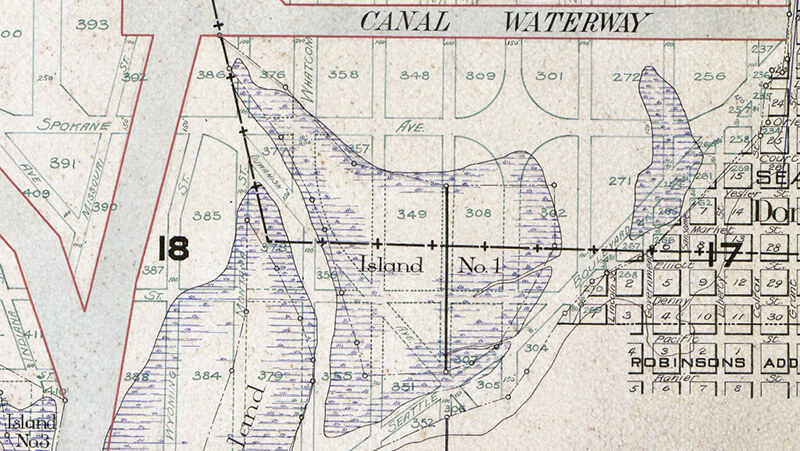This street was created in 1895 as part of the Seattle Tide Lands plat. As I wrote in S Spokane Street, “Streets in this plat that were not extensions of already existing ones, such as Commercial Street, were named after letters of the alphabet, American cities, American states, prominent local politicians, and places in Washington”; these last included Chelan, Duwamish, Kitsap, Klickitat, Queets, Quilcene, Quileute, Quinault, Spokane, Vashon, Wenatchee, and Whatcom, the ones in italics still existing today. It seems strange to me that the Duwamish name would have been applied to such a short street, it being the name of Seattle’s principal river (dxwdəw) and indigenous inhabitants, the Duwamish Tribe (dxʷdəwʔabš), but there you have it. At least it still exists.
In “Elliott Way” just a placeholder name, I quote an email I wrote to the Seattle City Council and the Waterfront Seattle Program in December 2020 which read, in part, “I urge you… to name [Elliott Way] something else. The Duwamish people, for example, have Duwamish Avenue S named for them (actually more likely for the river…), but it is an insignificant street 2/10 of a mile long hidden under the Spokane Street Viaduct and the Alaskan Freeway. Perhaps Duwamish Avenue would be a better choice, if the tribe approved?” I still think this would be a good idea (and it would give us another naming opportunity as well). They did respond favorably, said they had been thinking along the same lines, and as of January 2022 “continue to coordinate with the tribes and other partners on a proposed name.” I hope they come up with something soon, as what is still being referred to as Elliott Way is due to open by year’s end!
As I mentioned in my email, Duwamish Avenue S is 2/10 of a mile long, beginning at E Marginal Way S and ending at a Port of Seattle road just south of the West Seattle and Spokane Street Bridges.
Update as of February 2, 2023: I posted an article last month — “Dzidzilalich” to be honorary name for Elliott Way, Alaskan Way — noting that, in fact, the roadway will be known as Elliott Way… but will carry the honorary name “Dzidzilalich.” So it seems “Elliott Way,” after all, is unfortunately not just a placeholder name, and for now the Duwamish name remains confined to this obscure thousand-foot-long street.

Born and raised in Seattle, Benjamin Donguk Lukoff had his interest in local history kindled at the age of six, when his father bought him settler granddaughter Sophie Frye Bass’s Pig-Tail Days in Old Seattle at the gift shop of the Museum of History and Industry. He studied English, Russian, and linguistics at the University of Washington, and went on to earn his master’s in English linguistics from University College London. His book of rephotography, Seattle Then and Now, was published in 2010. An updated version came out in 2015.

Benjamin,
A very interesting website! We stumbled across it while trying to get information about Whatcom Avenue – you mention it twice in this particular post. In particular we would like to know when Whatcom Ave. was renamed to E. Marginal Way S. The reason for our interest is that the railroads in the area sometimes referred to the tracks adjacent to this roadway as ‘Whatcom Ave. Yard’; the tracks were apparently given that name in 1941.
Any information you could provide would be gratefully accepted!
Thanks,
Jim Providenza
Thanks for your comment, Jim! I’ll do a little research and get back to you. I believe it was sometime in the 1920s.
So the last year I see Whatcom Avenue mentioned in the Times or P-I as a current, not historical, street name is 1931. But for a number of years before then, I see both Whatcom Avenue and East Marginal Way being used, and there are a couple of articles referring to both names, one being present, one historic.
The last year Whatcom Avenue is mentioned in a city ordinance is 1925. Yet Kroll’s 1920 city atlas shows the road as East Marginal Way.
My best guess is that it was always intended to extend the East Marginal Way name all the way to Railroad Avenue (today’s Alaskan Way, of course), but that it took a while for the usage to take hold, and the official change came sometime in the early 1920s. Unfortunately I can’t find a specific ordinance extending the name.
Hope that helps!
Oh — I should add that I found a reference to the Whatcom Avenue Yard in a publication of the United States National Railroad Adjustment Board from 1936. Not sure why they would have used an old street name…
Benjamin,
Thanks so much for digging into Whatcom Ave. I will kick your results around in our group and let you know if we can come up with any more information. As to why a railroad would use a name of a historic street for one of their yards – railroads rarely changed names if they could avoid it. Doing so could create confusion with disastrous results – read train wreck! One scenario would have a small yard named for the nearby street (very common) and then when the street name changed the railroad did not change the name of the yard.
You’re welcome! That makes total sense about not wanting to change names, but since it appears the yard was given its name after Whatcom Avenue became East Marginal Way…. perhaps they just thought East Marginal Yard wouldn’t be a good name because the street is so long and it wouldn’t be geographically specific enough.